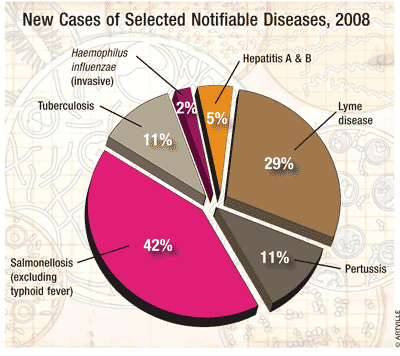US Pharm. 2011;36(8):10.
In ambulatory care settings, 24.2 and 3.9 million visits to office-based physicians and hospital outpatient departments, respectively, were made in 2008 for the treatment of infectious and parasitic diseases, according to the CDC.

Haemophilus influenzae Infection: Mortality from invasive H influenzae has been low (0.1/100,000 population) because 55% of children aged 19 to 35 months receive primary and booster doses of the vaccine. Thirty-three percent of children aged 2 to 17 years, 23% of adults aged 18 to 49 years, 41% of those aged 50 to 64 years, and 67% of those aged 65 years and older have been vaccinated.
Hepatitis A and B: Morbidity from hepatitis (4,033 new hepatitis B cases, 2,585 new hepatitis A cases) has been significantly low. This is partly because of the high rate of vaccination with more than three doses (92% of children aged 19-35 months). Although mortality is low (2.5 deaths per 100,000 population), the number of deaths (7,407) offsets the number of new cases (6,618) during the same period.
Lyme Disease (LD): LD, the most common tickborne disease (7.9/100,000 persons), is one of the fastest-growing (35,198 new cases in 2008) infectious diseases in the United States. Ten states have a high morbidity rate, with an average of 31.6 new cases per 100,000 persons. LD is found in 49 states, but 99% of cases have occurred in just five geographic areas (New England, Mid-Atlantic, South Atlantic, East North Central, West North Central).
Pertussis: In 2008, 13,278 new cases of pertussis were reported, even with 84% of children aged 19 to 35 months and 56% of adolescents aged 13 to 17 years receiving the recommended number of vaccine doses. Secondary attack rates exceeding 80% occur among household members even though pertussis is rarely airborne. Twenty percent to 47% of adults exposed to pertussis develop infection. Adult pertussis is underreported, as many cases go unrecognized or misdiagnosed.
Salmonellosis (Excluding Typhoid): In 2008, 51,040 new cases of salmonellosis were reported, even though the average annual number of new cases is approximately 40,000. According to the National Surveillance Program, estimated morbidity ranges from 0.8 million to 3.7 million (annual mean of 1.9 million and median of 1.4 million infections).
Tuberculosis (TB): In 2008, approximately 12,900 new cases of TB were reported. In contrast to the high rate of incidence of TB worldwide, the rate has declined in the U.S. and 15 million people have been infected with Mycobacterium tuberculosis. The overall incidence rate in the U.S. is 7.4/100,000 individuals, but in high-risk groups the rate climbs to 32 to 100 per 100,000 individuals.
To comment on this article, contact rdavidson@uspharmacist.com.





